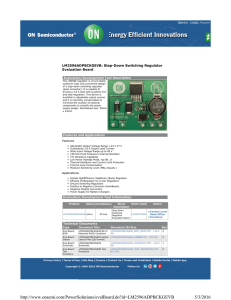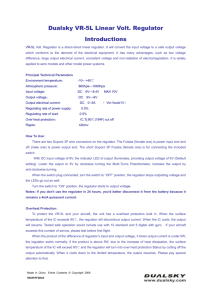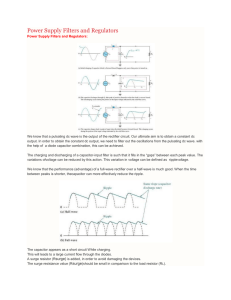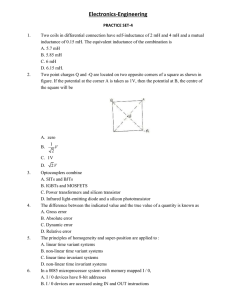Paper - Asee peer logo
advertisement
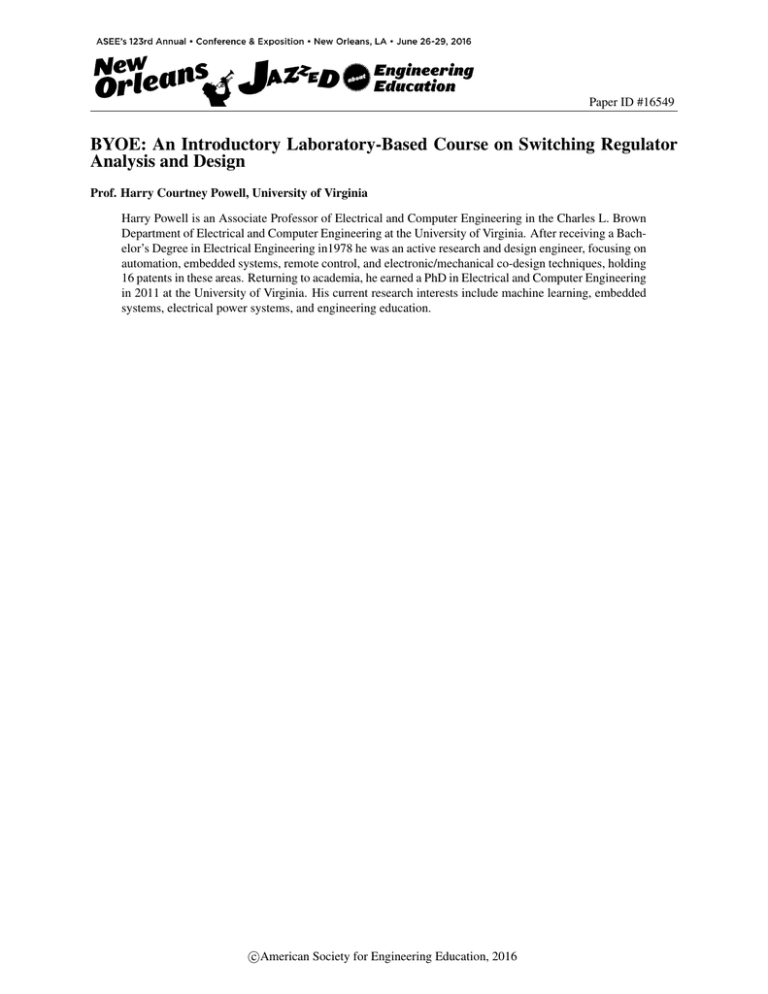
Paper ID #16549 BYOE: An Introductory Laboratory-Based Course on Switching Regulator Analysis and Design Prof. Harry Courtney Powell, University of Virginia Harry Powell is an Associate Professor of Electrical and Computer Engineering in the Charles L. Brown Department of Electrical and Computer Engineering at the University of Virginia. After receiving a Bachelor’s Degree in Electrical Engineering in1978 he was an active research and design engineer, focusing on automation, embedded systems, remote control, and electronic/mechanical co-design techniques, holding 16 patents in these areas. Returning to academia, he earned a PhD in Electrical and Computer Engineering in 2011 at the University of Virginia. His current research interests include machine learning, embedded systems, electrical power systems, and engineering education. c American Society for Engineering Education, 2016 BYOE: An Introductory Laboratory Based Course on Switching Regulator Analysis and Design Presenter Information: The author welcomes the opportunity to collaborate on the development of courseware related to switching regulator and energy conversion laboratories. Design files and printed circuit fabrication for these experimental setups are available as well. Contact information: Prof. Harry Powell Electrical and Computer Engineering University of Virginia Charlottesville, Virginia 22904 hcp7ad@virginia.edu Summary To broaden our curriculum in electrical and computer engineering, we have expanded our upperlevel elective offerings to include a series of 1.5 credit hour laboratory courses that are designed to complement existing courses, or to encourage students to reach out into a subject area with which they are not previously familiar. These courses have generated great interest, and virtually all of our 3rd and 4th-year students are engaged with them. This presentation will focus on our development of low-cost laboratory experiments that cover the design and analysis of the most common switching regulator topologies, i.e. buck, boost, and buck-boost designs. Also, a typical linear voltage regulator will be demonstrated to serve as a basis for comparison and allow the students to gain a sense of the trade-offs involved in voltage regulator design. We have designed accessories that enable students to perform transient load testing, and power supply step response to changing input voltages. A very compact setup will be demonstrated that can be readily adapted to a typical laboratory bench setup as might be typically found in an undergraduate circuits or electronics course. Pedagogical Context We have witnessed a steady increase in interest in alternate energy topics among electrical and computer engineering students, and a number of our graduates are seeking careers in energyrelated fields. In the Spring of 2015, we conducted a survey of 2nd year Electrical and Computer Engineering students through our Fundamentals of Electrical Engineering courses to assess student interest in a laboratory class devoted to an energy-related topic.1 The results indicated that 80% were interested in learning about energy efficient systems design and would either be "very likely" or "absolutely certain" to take a laboratory course that illustrated how such systems are designed and analyzed. Switching voltage regulators are at the heart of nearly all alternate energy system designs that involve electrical machines and devices, thus motivating an introduction to the techniques involved in realizing such devices; the principles involved in switching regulator design and analysis are pertinent to virtually all areas of power electronics. Also, they are not frequently covered in traditional coursework. There have been a number of approaches to power electronic education. Some universities employ a simulation-based approach or use remote access techniques to a larger simulation based environment with multimedia content.2,3 Other approaches focus on high-level concepts tied very closely to a particular technology.4 Some course offerings tend to require large amounts of dedicated space and very expensive equipment requiring significant industry contributions.5 Furthermore, equipment suppliers tend to offer equipment that is targeted at large industrial users and is not necessarily adaptable to the needs of a general electrical engineering educational laboratory.6,7 In most cases it appears that the equipment and space required are not necessarily adaptable to a studio-style classroom environment, which we have found to be a successful instructional approach.8,9 Our laboratory equipment as well as the overall course approach is designed with several goals in mind. We required a small laboratory footprint due to space limitations. Furthermore due to budget concerns we wished to exploit conventional bench equipment as much as possible, allowing us to leverage both space and the instruments used for our core 2nd and 3rd-year courses. Also, we wished to introduce switching regulator concepts at a level that is approachable to upper-level undergraduates in electrical and computer engineering. Our equipment and approach are readily adaptable to a number of different class scenarios. At the University of Virginia we have used it as a 4th-year technical laboratory elective, taught in a mixed lecture-laboratory studio approach. However, it could also be employed as the laboratory component of a more traditional lecture-based class, or even as auxiliary laboratories in an existing electronics course. Equipment and Laboratory Setup We have focused on a very compact and low-cost bench setup as shown in Figure 1. For the switching regulators to test we have employed the PMLK™ educational kits from Texas Instruments.10. These kits offer several different small evaluation switching regulator topologies including linear low dropout, buck, boost, and buck-boost. Figure 2 shows the standard complement of boards available. These boards are designed for the modest power levels available from typical bench supplies used in undergraduate laboratories. Additionally, they have a large number of test-points that allow visibility into critical interior nodes and facilitate explaining concepts through an actual experiment in addition to theory and simulation. It should be noted that several manufacturers offer evaluation boards for their voltage regulator chips, and these could easily be employed as well. Figure 1 Switching Regulator Laboratory Bench Setup Figure 2 Voltage Regulator Kits (From svnq001.pdf available at ti.com) Our space requirements are further reduced via use of the VirtualBench™ from National Instruments.11 This compact piece of equipment uses a laptop computer or other portable device as a display and includes a 100MHZ oscilloscope, function generator, DVM, and a triple output power supply. This basic suite of boards and equipment is sufficient to test basic regulator operation and quantify efficiency over a range of input voltages and output loads. It also allows students to observe switch node waveforms and observe the noise spectrum as in Figure 3. Figure 3 Observation of Switch Node and Noise Spectrum Additionally, Texas Instruments has made available a web-based tool, WEBENCH™, that allows students to simulate each of the topologies and compare the results with those measured on the bench.12 This tool, Figure 4, allow students to compare virtually all key parameters and interior nodes of their experimental setups. Figure 4 Typical WEBENCH Display Additional Equipment for Extended Functionality We have extended the functionality of the laboratory with two small general-purpose add-on boards designed and fabricated at UVA. The first is a general purpose load switching board for testing transient load response. This board allows one to replace much of the functionality of a large programmable electronic load which typically costs several thousand dollars with a small circuit board comparable in size to the original voltage regulators under test. This board is shown in Figure 5. It is equipped with two pairs of alligator clips for clipping in resistors of various wattages and resistance ratings. The right pair is for a constant minimum load, and the left pair is for a lower valued resistor that will increase the total load when switched on. The alligator clips facilitate rapid changeover of resistances and act as heatsinks in combination with large copper areas on the board. This has proven entirely adequate for loads of the typical wattage supplied by bench supplies. Figure 5 Transient Load Switch The schematic is shown in Figure 6. J3 and J4 correspond to the right alligator clips; J2 and J1 to the left. J5 is for the output of the voltage regulator under test. The MOSFET, Q1, is rated at 17 amperes and has a typical on-state resistance of 0.065 ohms. In normal operation, it is either off or completely enhanced and exhibits negligible power dissipation. The circuit is triggered from a standard bench signal generator, and typically a square wave at 10 volts amplitude, will drive Q1 to a fully enhanced state. U1 is a transient voltage suppressor that protects the gate of Q1 and R2 guarantees that Q1 will be in the off state if the signal generator is accidentally disconnected. This board is very low in cost. It is also extremely easy to assemble; an overlay of the physical layout is shown in Figure 7. In our first offering of the class, we had the students assemble the board as an in-class project! The board design was performed with MultiSim and UltiBoard from National Instruments.13 Figure 6 Transient Load Switch Schematic Figure 7 Overlay of Transient Load Switch Printed Circuit A complete bench setup with the transient load testing addon is shown in Figure 8. Note that this compact arrangement allows us to test efficiency as a function of loads and input voltages, load transient response, and observe critical nodes in the regulator circuitry while employing no further resources than that typically found in a typical undergraduate circuits or electronics laboratory. It is also useful to note that by adjusting the gate drive, it is possible to optimize the transient load testing for either rising or falling loads, and to change the effective rise and fall times as well. Figure 8 Complete transient load testing bench setup We have also developed a second addon that allows testing voltage regulator response to transient input voltages. The schematic is shown in Figure 9. This circuit uses the MOSFET, U4, in a feedback loop that stabilizes the output voltage to the same magnitude as that on the non-inverting input of U3, i.e., a power follower. U9 is an isolated DC-DC converter that supplies the power for U3. This enables the use of the 5-volt power supply typically found in a triple output bench supply to provide 30 volts for U3, which gives adequate headroom for the range of input voltages that might be contemplated for use in the scale of experiments that we consider appropriate for this class. It should also be noted that the 5 volt supply would typically be unemployed otherwise, and this allows us to keep the experimental setup consistent with the goal of working within the constraints of equipment availability in an undergraduate laboratory. J1 is an input that sets the output voltage and would typically be driven by a signal generator configured to generate a pulse train for the anticipated output voltages. This arrangement not only allows us to test step response but also, if the signal generator is equipped with an arbitrary waveform capability, one can generate virtually any input; the 60 or 120HZ ripple voltage from a rectifier-capacitor supply would be extremely useful. The board layout, while more complicated than the transient load tester is still very simple and is also low in cost. Please note that this board was completed after the end of the current class and not available for the students. However, it is currently in production, and we expect to employ it for the Fall semester. Figure 9 Supply Transient Tester Figure 10 Supply transient board overlay The finished version of the board is shown in Figure 11. Figure 11 Supply transient voltage tester Notes on laboratory exercises We have used this equipment for a 1.5 credit-hour class in the Fall 2015 semester with the class meetings scheduled for twice-weekly and conducted in a studio style environment. Each class meeting started with a brief lecture that explained the theory of the particular regulator under consideration, with a focus on what differentiated that particular topology from the others under consideration. We also considered typical applications for that week's topology and looked at simulations. We employed linear voltage regulators as an introduction to the principles of voltage regulation and examined the effects of load current and input voltage on efficiency. The second regulator to be considered was the buck switching regulator, as it is the simplest of the switching topologies to understand, and illustrates the basic principles of other more advanced one. We then move to the boost topology and finally to the buck-boost. The overall schedule of the course was conducted in 3 segments; each of the core topologies was re-examined in each segment. In the first section of the course, we examined basic functionality, especially input and output voltage ranges, and efficiency. In the second part of the semester, we focused on the transient response to load changes and feedback loop stability. In this segment, we were able to explore how stability was affected by the reactive components that were part of the basic regulator as well as the loop compensation components and switching frequency. In the final segment of the course, the students delved into an application of their choice and did extensive analysis of which topology would be appropriate and anticipated results using WEBENCH. Applications to coursework We also anticipate that this suite of boards and experiments could be adapted to other teaching pedagogies and classroom structure. For example in a traditional course with separate laboratory and lecture sessions, more time could be devoted to theoretical analysis and detailed homework assignments could be developed. The laboratories would then be focused on a "measure and confirm" approach. Another approach would be to use several of these experiments as part of a first or second electronics course without going through the whole experimental suite. Additionally, several of these experiments could easily supplement a traditional "motors and transformers" based energy conversion course. Also, they are small enough to be used as in-class demonstrations for courses that are entirely lecture-based. We are currently also running a small pilot follow-on course that is conducted in a project-based approach where the students involved specify performance parameters, design (including printed circuit), and test a regulator board that could be used in subsequent offerings of our initial course offering. We have found that this type of student involvement in curriculum development is a valuable tool in developing enthusiasm for within our program.9 Student comments were favorable and indicated that courses such as this one were an asset to our curriculum. Summary and Conclusions We have found student interest in topics related to the generation and control of electrical energy to be at an all-time high. The perceived societal needs and timeliness of the subject are both engaging and relevant. The fundamental operating principles of switching regulators lie at the heart of all high-efficiency power control techniques as well as in systems as diverse as lighting controls and electric vehicles. As electrical engineering curricula evolve to meet the demands of the 21st century, it will become increasingly important to develop laboratory techniques to introduce this topic area to as many students as possible. We have demonstrated an approach to switching regulator laboratory design and analysis that is both inexpensive to implement and requires a small laboratory footprint. Our add-on boards dramatically increase the breadth of experiments that may be conducted with small evaluation regulator boards available from a variety of manufacturers. Also, experiments of this scope may be easily adapted to coursework in a wide range of classroom settings, significantly enhancing their utility. References 1. Dr. Harry Powell, Dr. Ronald Willians, Dr. Maite Brandt-Pearce, Dr. Robert Weikle. "Towards a T Shaped Electrical and Computer Engineering Curriculum: a Vertical and Horizontally Integrated Laboratory/Lecture Approach.", In: Proceedings of ASEE Annual Conference 2015. Seattle WA. 2. Choi J, Mok H. "Simulation based Power Electronics Education in Korea.", In: Power Conversion Conference - Nagoya, 2007 PCC ’07. 2007. p. 491–5. 3. Rojko A, Bauer P. "Education in power electronics based on remote resources: Three approaches and lessons learned.", In: Power Electronics and Motion Control Conference and Exposition (PEMC), 2014 16th International. 2014. p. 839–44. 4. Ochs DS, Miller RD. "Teaching Sustainable Energy and Power Electronics to Engineering Students in a Laboratory Environment Using Industry-Standard Tools.", IEEE Trans Educ. 2015 Aug;58(3):173–8. 5. Power Electronics Lab - Laboratory Facilities - Electrical Engineering Department - Cal Poly [Internet]. [cited 2016 Jan 23]. Available from: http://www.ee.calpoly.edu/facilities/powerelectronics/ 6. Model 8500, Programmable DC Electronic Loads - B&K Precision [Internet]. [cited 2015 Nov 13]. Available from: http://www.bkprecision.com/products/dc-electronic-loads/8500300-w-programmable-dc-electronic-load.html 7. Programmable DC Electronic Load | Chroma ATE Inc. [Internet]. [cited 2015 Nov 13]. Available from: http://www.chromaate.com/product/6310A_series_Programmable_DC_Electronic_Load.ht m 8. Carlson AB, Jennings WC, Schoch PM. "Teaching circuit analysis in the studio format: a comparison with conventional instruction.", In: Frontiers in Education Conference, 1998 FIE ’98 28th Annual. 1998. p. 967–70 vol.2. 9. Dr. Harry Powell, Prof. Joanne Bechta Dugan. "Embedded computing reinforces and integrates concepts across ECE curriculum.", In: Proceedings of the Annual Conference of the ASEE, 2014. Indianapolis, Indiana; 2014. 10. Power Management Lab Kit (PMLK) PRO - Educators - Wiki - Educators - TI E2E Community [Internet]. [cited 2015 Nov 13]. Available from: https://e2e.ti.com/group/universityprogram/educators/w/wiki/2993.power-management-labkit-pro 11. NI VirtualBench All-in-One Instrument - National Instruments [Internet]. [cited 2014 Nov 30]. Available from: http://www.ni.com/virtualbench/ 12. WEBENCH Design Center - TI.com [Internet]. [cited 2015 Nov 13]. Available from: http://www.ti.com/lsds/ti/analog/webench/overview.page?DCMP=sva_web_webdesigncntr _en&HQS=sva-web-webdesigncntr-vanity-lp-en 13. NI Ultiboard – Printed Circuit Board Layout and Routing - National Instruments [Internet]. [cited 2014 Dec 1]. Available from: http://www.ni.com/ultiboard/
